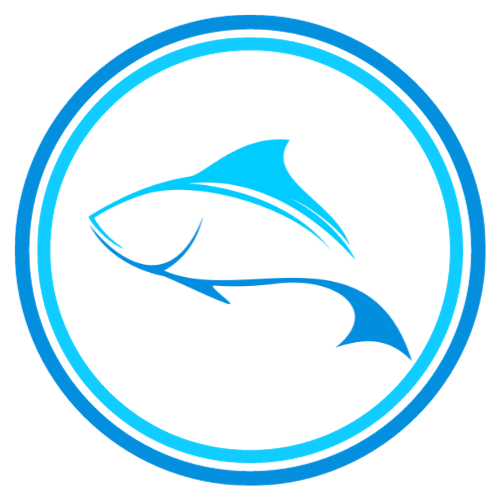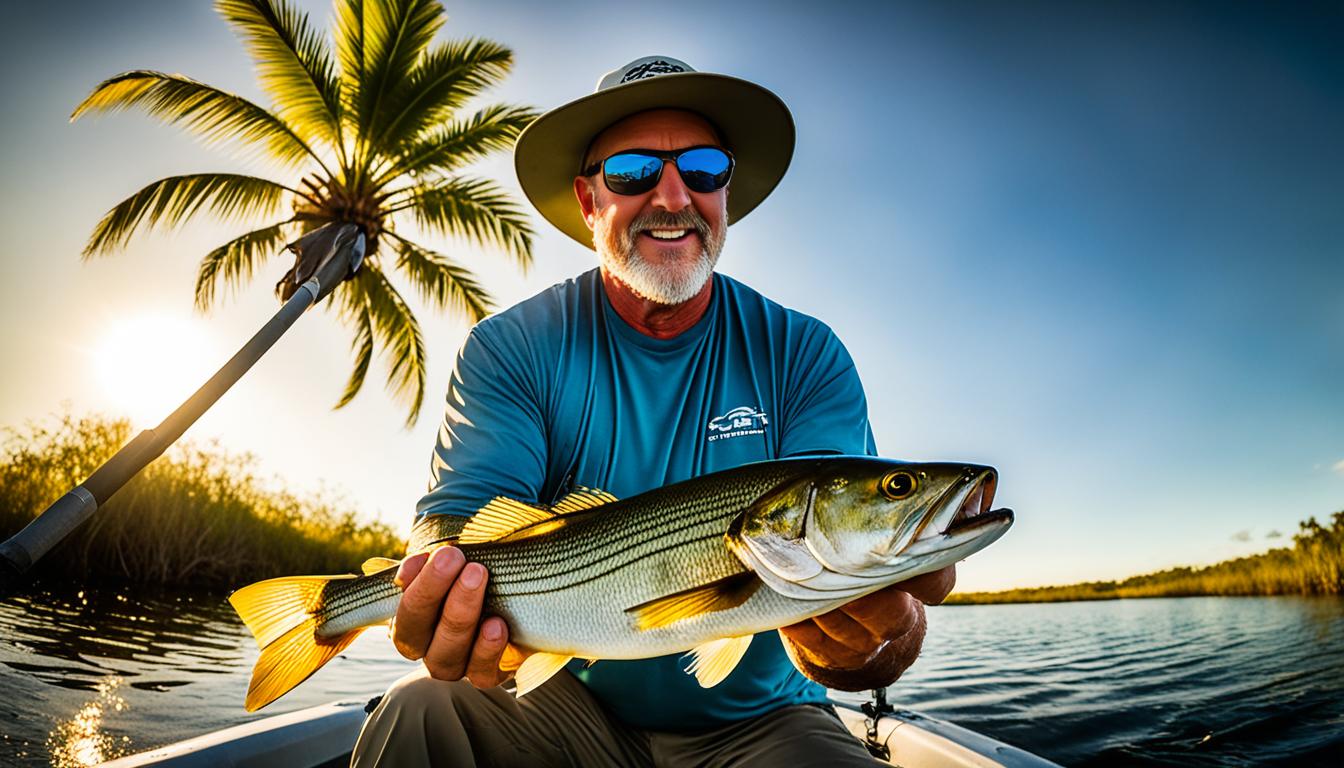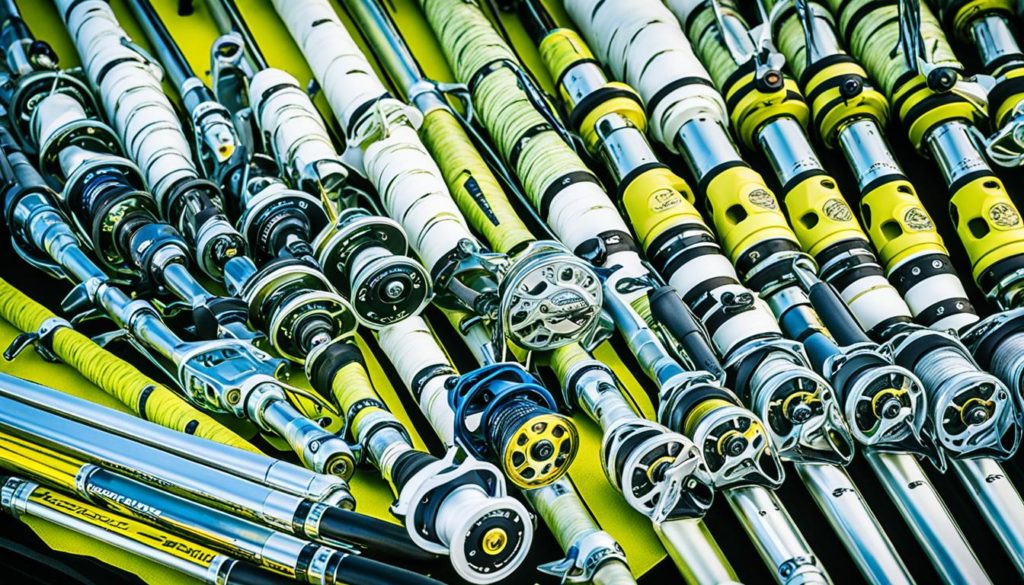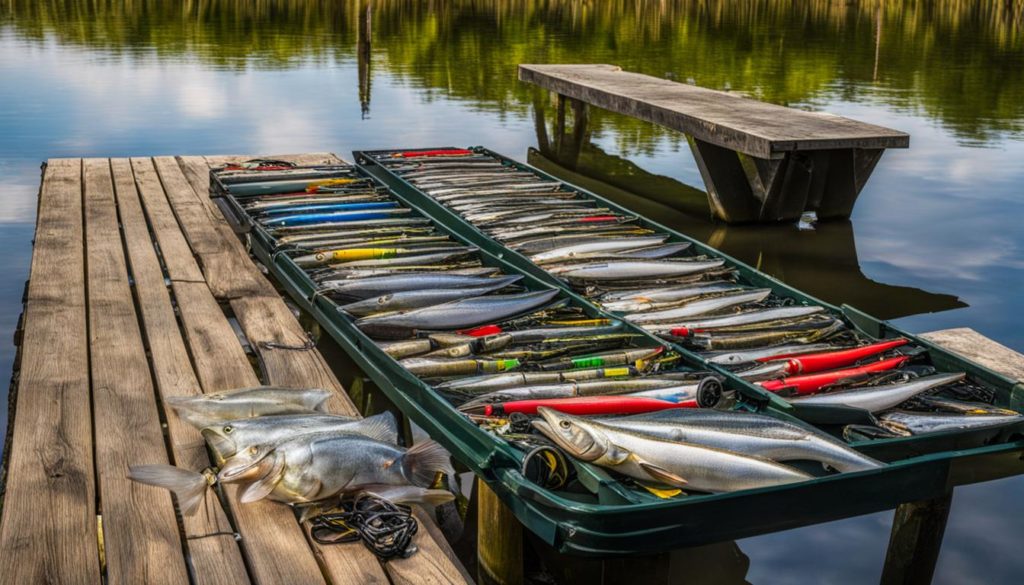Snook are a popular fish species in Florida, and if you want to learn how to catch them, you’ve come to the right place. Whether you’re a beginner or an experienced angler, this ultimate guide will provide you with valuable insights and tips to enhance your snook fishing skills in the beautiful waters of Florida.
Key Takeaways:
- Snook are found in both saltwater and freshwater environments, hiding around structures such as grass flats, mangroves, and bridges.
- The best time to fish for snook is from spring to early fall when the waters are warm.
- Live baits like shrimp, pinfish, and sardines, as well as artificial lures such as paddle tails and topwater plugs, are effective in catching snook.
- Snook can be caught using various techniques, including night fishing and sight casting.
- It’s crucial to follow the snook fishing regulations set by the Florida Fish and Wildlife Conservation Commission to ensure sustainable fishing practices.
Best Baits and Lures for Snook Fishing in Florida
When it comes to catching snook in Florida, using the right baits and lures is essential. Popular choices include live baits such as shrimp, pinfish, mullet, and sardines. These can be used with a variety of rigs, including a 4/0 circle hook and a popping cork or float rig. Artificial lures like paddle tails, topwater plugs, soft plastics, and jigs are also effective in enticing snook bites. The key is to mimic their natural prey and present the bait or lure in a way that entices the snook to strike.
Bait and Lure Options:
| Type | Examples |
|---|---|
| Live Bait | Shrimp, pinfish, mullet, sardines |
| Artificial Lures | Paddle tails, topwater plugs, soft plastics, jigs |
When using live bait, you can rig it on a 4/0 circle hook to ensure a good hookset. Adding a popping cork or float rig can help attract snook by creating noise and movement in the water. Experiment with different retrieval speeds and techniques to find what works best.
Artificial lures should mimic the appearance and movement of snook’s natural prey. Paddle tails and soft plastics can imitate baitfish, while topwater plugs can entice surface strikes. Jigs with soft plastic trailers can be effective for both sight casting and fishing structure.
Remember, snook are wary and intelligent predators, so presentation is key. Vary your retrieve, experiment with different colors, and pay attention to the conditions and behavior of the snook. By using the right baits and lures, you can increase your chances of hooking into a trophy snook in Florida.
The Best Time and Locations to Fish for Snook in Florida
When it comes to snook fishing in Florida, timing and location are crucial to increase your chances of a successful catch. Snook can be found in various spots throughout the state, offering anglers a diverse range of fishing opportunities. Whether you prefer canals, rivers, beaches, grass flats, mangrove roots, docks, inlets, spillways, bridge pilings, or nearshore waters, there’s a perfect spot for you to target these prized game fish.
Each location may have its peak seasons for snook fishing, depending on the behavior and migratory patterns of the fish. Inshore waters and estuaries, such as Jupiter, Boca Grande, Fort Pierce, and Vero Beach, tend to be more productive from April to September, when snook move closer to shore to feed and reproduce. During this time, they can often be found hiding around structures such as mangroves, oyster beds, and grass flats.
As the year progresses, different locations become more active. For example, rivers and piers, like the ones near Sanibel and in the Fort Myers area, become excellent spots for snook fishing later in the year. Snook seek shelter in deeper waters and can be found near bridge pilings, spillways, and other structures where they can ambush their prey.
It’s essential to stay updated on the snook fishing regulations and season dates set by the Florida Fish and Wildlife Conservation Commission (FWC) to ensure responsible angling practices. This includes knowing the bag limits, size restrictions, and any specific rules or closures that may apply to certain areas at different times of the year. Adhering to these regulations not only contributes to the conservation of snook populations but also ensures a sustainable fishing experience.
| Snook Fishing Spots in Florida | Peak Season |
|---|---|
| Jupiter | April-September |
| Boca Grande | April-September |
| Fort Pierce | April-September |
| Vero Beach | April-September |
| Sanibel | October-March |
| Fort Myers Area | October-March |
Chart illustrating the peak seasons for snook fishing in popular Florida locations.
By strategically planning your fishing trips based on the best time and locations for snook fishing in Florida, you can optimize your chances of hooking into these elusive and exciting game fish. Whether you’re targeting snook in the coastal waters of Jupiter or the estuaries of Boca Grande, there’s an adventure waiting for you to embark on.
Tips and Techniques for Snook Fishing in Florida
Snook fishing in Florida requires specific techniques and strategies to increase your chances of success. Follow these tips to improve your snook fishing skills and make the most of your fishing experience.
1. Be Stealthy
When targeting snook, it’s essential to be stealthy and avoid making excessive noise that could startle the fish. Snook have sharp senses and can be easily spooked. Move quietly and minimize any disturbances in the water to increase your chances of a successful catch.
2. Cast Up-Current
Casting your bait or lure up-current from the snook is a proven technique. This allows the bait to naturally drift towards the fish, giving it a realistic presentation. Snook are opportunistic feeders and often wait for prey to come to them, so take advantage of their feeding behavior by positioning your bait or lure strategically.
3. Match the Hatch
One of the keys to success in snook fishing is using baits or lures that resemble the fish’s natural prey. Pay attention to the local forage available in the area you are fishing and select baits or lures that mimic those prey species. Snook are known to feed on shrimp, mullet, pinfish, and other small fish, so choose your bait accordingly.
4. Use the Right Gear
Having the right gear is crucial when targeting snook. Use light tackle that allows you to feel the fish’s subtle strikes and make accurate casts. Adjust your gear based on the size of the snook you are targeting. A medium to medium-heavy spinning rod with a reel spooled with 15-20 lb test line is a popular choice. Additionally, consider using fluorocarbon leaders to increase your chances of landing these powerful fish.
5. Be Patient and Observant
Snook fishing requires patience and observation. Take the time to study the water, look for signs of baitfish activity, and watch for any movement that could indicate the presence of snook. Be mindful of the tide, currents, and weather conditions as they can influence the fish’s behavior and feeding patterns. Adapt your fishing techniques accordingly.
6. Embrace Adaptability
Snook can be unpredictable, and fishing conditions can change rapidly. To increase your chances of success, be adaptable. Experiment with different baits, lures, and techniques to find out what works best on a given day. Don’t be afraid to adjust your approach based on the feedback you’re getting from the fish or the conditions you’re facing.
By following these tips and techniques, you’ll be well equipped to catch snook in Florida. Remember to stay informed about the fishing regulations set by the Florida Fish and Wildlife Conservation Commission (FWC) and practice ethical fishing practices to ensure the sustainability of the snook population.
Snook Fishing Regulations in Florida
When planning a snook fishing trip in Florida, it is essential to familiarize yourself with the snook fishing regulations set by the Florida Fish and Wildlife Conservation Commission (FWC). These regulations are in place to protect the snook population and ensure sustainable fishing practices. By following these guidelines, you can contribute to the conservation of this prized fish species.
The current recreational harvest season for snook in Florida spans from September 1st to November 30th on the Gulf Coast, and from December 1st to the end of February on the Atlantic Coast. It’s important to note that these dates may be subject to change, so it’s best to consult the FWC website for any updates or modifications to the season.
In addition to specific season dates, there are also size and bag limits in place for snook fishing. At the time of writing, the size limit for snook in Florida is 28 to 32 inches in total length. It’s important to measure the snook accurately and release any undersized or oversized fish promptly to ensure their continued survival.
The bag limit for snook in Florida is currently one fish per person per day. This means that you are only allowed to keep one snook per day within the specified size limit. Once you have caught your limit, it is crucial to release any additional snook you may catch to conserve the population for future generations.
It’s also worth mentioning that certain areas or specific bodies of water may have additional regulations or restrictions in place. These could include area-specific closed seasons, tackle restrictions, and gear limitations. Therefore, it is crucial to consult the FWC website for the most up-to-date and accurate information regarding regulations in your chosen fishing location.
By adhering to these snook fishing regulations, you can enjoy the thrill of hunting for snook while contributing to the conservation efforts for this iconic Florida gamefish.
Guided Snook Fishing Charters in Florida
If you want to maximize your chances of catching snook in Florida, booking a guided fishing charter is a great option. Professional fishing guides have extensive knowledge of snook behavior, the best fishing spots, and techniques. They can provide all the necessary equipment, including boats, tackle, and bait. Guided fishing charters offer a personalized experience, tailored to your skill level and preferences. Whether you’re a beginner or an experienced angler, a guided snook fishing charter can provide valuable insights and increase your chances of landing a trophy snook.
Why Choose Guided Snook Fishing Charters?
1. Expertise: Fishing guides have years of experience and intimate knowledge of snook behavior, enabling them to optimize your fishing experience.
2. Best Fishing Spots: Guides know the top snook fishing locations, ensuring you fish in the most productive areas.
3. Equipment Provided: From boats to tackle and bait, everything you need for a successful fishing trip is taken care of by the charter.
4. Tailored Experience: Guides personalize the trip to accommodate your skill level, preferences, and fishing goals.
5. Learning Opportunities: Guides are excellent teachers, imparting their knowledge and techniques to help you improve your snook fishing skills.
6. Insider Tips: Gain valuable insights into the unique nuances of snook fishing, such as ideal weather conditions, feeding patterns, and presentation techniques.
7. Convenience: Guided fishing charters handle all the logistics, allowing you to focus solely on enjoying your fishing adventure.
What to Expect on a Guided Snook Fishing Charter
During a guided snook fishing charter, you can expect a well-rounded experience that combines education, adventure, and adrenaline-fueled fishing. Here’s what you can anticipate during your trip:
- Meeting the Guide: Your charter will begin with meeting your knowledgeable fishing guide, who will provide an overview of the day’s plan and share insights about snook fishing in Florida.
- Equipment Set-up: The fishing guide will provide all the necessary fishing gear and help you set it up based on the techniques and locations you’ll be targeting snook.
- Boat Ride: Embark on a comfortable and well-equipped fishing boat, specially designed for shallow water and snook fishing.
- Scenic Locations: Explore the picturesque waters of Florida, navigating through the prime snook fishing spots chosen by your guide.
- Fishing Techniques: Learn various snook fishing techniques, such as live bait fishing, lure fishing, and sight casting, tailored to your preferences and skill level.
- Guidance and Tips: Benefit from the expertise of your fishing guide, who will offer guidance, tips, and tricks throughout the trip to improve your chances of landing snook.
- Exciting Strikes: Experience the exhilaration of snook striking your bait or lure, and enjoy the adrenaline rush as you battle these powerful and acrobatic fish.
- Education and Fun: While fishing, your guide will provide interesting facts about snook, their habitat, and the unique ecosystem of Florida’s waters.
- Relaxed Atmosphere: Unwind and enjoy the tranquility of the water, taking in the breathtaking views and surrounding wildlife.
- Capture Memories: Document your catches and memorable moments with photos, preserving the excitement of your snook fishing charter.
A guided snook fishing charter ensures a successful and enjoyable fishing trip, allowing you to focus on the thrill of angling and creating lasting memories.
Sample Table: Compare Guided Snook Fishing Charters
| Charter Company | Location | Duration | Price Range |
|---|---|---|---|
| Reel Adventures Charters | Boca Grande, FL | Half Day, Full Day | $400-$800 |
| Jupiter Inshore Fishing | Jupiter, FL | Half Day, Full Day | $350-$650 |
| Sanibel Offshore Fishing | Sanibel, FL | Half Day, Full Day | $450-$850 |
| Fort Myers Fishing Charters | Fort Myers, FL | Half Day, Full Day | $400-$800 |
Florida Snook Fishing Basics
Before heading out to catch snook in Florida, it’s important to have a basic understanding of snook fishing. This includes knowing the best times and locations to fish, using the right gear and tackle, understanding snook behavior, and following the fishing regulations. Snook fishing requires patience, observation, and adaptability.
Gear and Tackle
- Choose a medium to heavy-action spinning rod and reel combo for snook fishing.
- Use a high-quality braided line with a fluorocarbon leader to increase sensitivity and prevent break-offs.
- Select hooks and weights based on the fishing conditions and the size of snook you’re targeting.
- Suggested bait and lures include live bait (shrimp, pinfish, mullet) and artificial lures (jerkbaits, swimbaits, topwater plugs).
Snook Fishing Techniques
- When fishing for snook, cast your bait or lure near structures such as mangroves, docks, and grass flats where snook like to hide.
- Try different retrieval speeds and lure actions to mimic the movement of snook’s natural prey.
- Experiment with different depths and locations within your fishing area to locate active snook.
- Consider using a popping cork or float rig to add noise and attract snook’s attention.
- Be patient and wait for the snook to fully take the bait before setting the hook.
Fishing Tips
Here are some additional snook fishing tips to help you improve your success:
“Pay attention to the tides and fish during the incoming or outgoing tide for optimal snook feeding activity.”
“Try fishing during low-light conditions such as early morning or dusk when snook are more active.”
“If you’re fishing from a boat, approach your fishing spots quietly to avoid spooking the snook.”
| Tip | Description |
|---|---|
| Observe Snook Behaviour | Watch for snook feeding patterns and look for signs such as surface activity or baitfish schools. |
| Stay Versatile | Adapt your fishing techniques and lures based on the conditions and the snook’s response. |
| Handle with Care | When catching snook, handle them with wet hands to protect their slime coat, and practice catch and release for sustainability. |
By following these snook fishing tips and techniques, you’ll increase your chances of having a successful and enjoyable fishing experience in Florida.
Florida Snook Behavior
Understanding the behavior of snook is crucial for successful fishing in Florida. Snook are influenced by variables such as seasons, water temperature, and food sources. By familiarizing yourself with their behaviors, you can improve your chances of catching these elusive fish.
Snook Migration
Snook exhibit migratory patterns, moving to different areas depending on the time of year. From April to September, larger snook migrate towards estuaries, inlets, and bays for feeding and reproduction. These areas provide ample food sources and shelter for the snook population. During the colder months, snook seek refuge in rivers, canals, and deeper waters, where the water temperature is relatively warmer.
Feeding Habits
Snook are predatory fish that primarily feed on small fish, shrimp, and crustaceans. Their diet influences their behavior and determines their preferred habitats. Understanding their feeding patterns and selecting baits or lures that resemble their natural prey will greatly increase your chances of enticing a strike.
Habitat Preferences
Snook can be found in a variety of habitats, including mangroves, oyster beds, grass flats, bridge pilings, and reefs. These structures provide ideal hiding places for snook, allowing them to ambush their prey. By targeting these habitats during the appropriate seasons, you can locate areas with a higher concentration of snook.
Snook Fishing Seasons in Florida
It’s essential to be aware of the snook fishing seasons and regulations set by the Florida Fish and Wildlife Conservation Commission (FWC). The recreational harvest season for snook typically opens from September 1st to November 30th on the Gulf Coast, and from December 1st to the end of February on the Atlantic Coast. These seasons are designed to protect the snook population during their peak spawning periods.
Pro Tips for Catching Snook in Florida
Experienced anglers have developed various pro tips and strategies for catching snook in Florida. These techniques and tips can significantly improve your chances of landing a trophy snook. Mastering snook fishing techniques and strategies is crucial to outsmart these elusive and powerful fish.
Fishing during specific hours can greatly enhance your success. It’s recommended to fish during the hours before the incoming tide and two hours before the ebbing tide. During these periods, there is optimal water movement, which triggers snook feeding. Take advantage of these prime time windows to maximize your catch.
Additionally, fishing after rainfall can be highly productive. Rainfall washes baitfish and other prey into the water, attracting hungry snook. These opportune moments present excellent conditions for snook feeding and make them more likely to strike your bait or lure.
Night fishing with lures or live bait near dock lights can yield exceptional results, especially when targeting larger snook. Dock lights attract baitfish, which, in turn, attract snook. Choose lures or live bait that mimic the natural prey and present them in a way that entices snook to strike.
When handling caught snook, it’s imperative to do so with care. Hold the fish horizontally with both hands to support its weight properly. Minimize stress by avoiding excessive squeezing or bending of the fish. Treating caught snook with care ensures their survival after release and contributes to sustainable and responsible fishing practices.
By incorporating these pro tips and strategies into your snook fishing endeavors, you’ll increase your chances of success on the water. Remember to adapt your techniques to the current conditions, stay observant, and remain patient. With dedication and practice, you’ll develop the skills needed to consistently catch snook in the beautiful waters of Florida.
Conclusion
Snook fishing in Florida is a thrilling adventure for both beginners and seasoned anglers. By employing the right techniques, gear, and understanding of snook behavior, you can significantly enhance your chances of landing trophy-sized snook. Make sure to adhere to the fishing regulations established by the Florida Fish and Wildlife Conservation Commission (FWC) and practice catch-and-release to protect the sustainability of the snook population. Whether you decide to explore popular spots like Jupiter and Boca Grande or venture into lesser-known locations, Florida offers a diverse and rewarding snook fishing experience that will leave you hooked.
FAQ
What are some popular locations for snook fishing in Florida?
Jupiter, Boca Grande, Fort Pierce, Vero Beach, Sanibel, and the Fort Myers area are some of the premier destinations for snook fishing in Florida.
Where can snook be found in Florida?
Snook can be found in both saltwater and freshwater environments, hiding around structures such as grass flats, mangroves, oyster beds, bridges, reefs, and wrecks.
What are the best baits and lures for snook fishing in Florida?
Popular choices for baits include shrimp, pinfish, mullet, and sardines. Artificial lures like paddle tails, topwater plugs, soft plastics, and jigs are also effective in enticing snook bites.
When is the best time to fish for snook in Florida?
The best time to fish for snook in Florida is from spring to early fall when the waters are warm. Night fishing and sight casting can also be effective techniques for catching snook.
Are there any regulations for snook fishing in Florida?
Yes, it’s important to be aware of the snook fishing regulations set by the Florida Fish and Wildlife Conservation Commission (FWC), including size limits, bag limits, and specific seasons for harvest.
How can I improve my snook fishing skills?
Some tips for improving your snook fishing skills include being stealthy, using the right presentation, matching the hatch, using light tackle, and being patient, observant, and adaptable to changing conditions.
Are guided snook fishing charters available in Florida?
Yes, booking a guided snook fishing charter is a great option for maximizing your chances of success. Professional fishing guides have extensive knowledge and can provide all the necessary equipment and personalized experience.
What should I know before going snook fishing in Florida?
Before heading out to catch snook in Florida, it’s important to have a basic understanding of snook fishing, including the best times and locations to fish, the right gear and tackle to use, and the fishing regulations to follow.
Where do snook migrate to in Florida?
Snook migrate to different areas depending on the time of year, with larger snook moving towards estuaries, inlets, and bays from April to September for feeding and reproduction. During colder months, they seek shelter in rivers, canals, and deeper waters.
What are some pro tips for catching snook in Florida?
Some pro tips for catching snook in Florida include fishing during optimal water movement, fishing after rainfall, night fishing near dock lights, and handling caught snook properly to ensure their survival after release.
What can I expect from snook fishing in Florida?
Snook fishing in Florida offers both novice anglers and experienced fishermen exciting opportunities to land trophy fish. With the right techniques, gear, and knowledge of snook behavior, you can increase your chances of catching these aggressive and powerful fish.



